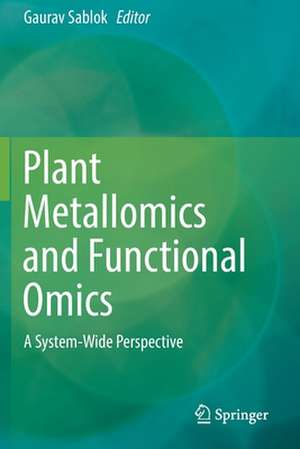Plant Metallomics and Functional Omics: A System-Wide Perspective
Editat de Gaurav Sabloken Limba Engleză Paperback – 14 aug 2020
| Toate formatele și edițiile | Preț | Express |
|---|---|---|
| Paperback (1) | 699.12 lei 43-57 zile | |
| Springer International Publishing – 14 aug 2020 | 699.12 lei 43-57 zile | |
| Hardback (1) | 952.72 lei 43-57 zile | |
| Springer International Publishing – 16 iul 2019 | 952.72 lei 43-57 zile |
Preț: 699.12 lei
Preț vechi: 822.50 lei
-15% Nou
Puncte Express: 1049
Preț estimativ în valută:
133.82€ • 145.41$ • 112.48£
133.82€ • 145.41$ • 112.48£
Carte tipărită la comandă
Livrare economică 21 aprilie-05 mai
Preluare comenzi: 021 569.72.76
Specificații
ISBN-13: 9783030191054
ISBN-10: 3030191052
Pagini: 332
Ilustrații: VIII, 332 p. 40 illus., 36 illus. in color.
Dimensiuni: 155 x 235 mm
Greutate: 0.48 kg
Ediția:1st ed. 2019
Editura: Springer International Publishing
Colecția Springer
Locul publicării:Cham, Switzerland
ISBN-10: 3030191052
Pagini: 332
Ilustrații: VIII, 332 p. 40 illus., 36 illus. in color.
Dimensiuni: 155 x 235 mm
Greutate: 0.48 kg
Ediția:1st ed. 2019
Editura: Springer International Publishing
Colecția Springer
Locul publicării:Cham, Switzerland
Cuprins
Energy crop at heavy metal contaminated arable land as an alternative for food and feed production: biomass quantity and quality.- Systems biology of metal tolerance in plants: a case study on the effects of long-term Cd-exposure on the stem of alfalfa.- One for all and all for one! Increased plant heavy metal tolerance by growth promoting microbes: a metabolomic standpoint.- Genomics and Physiological Evidence of heavy metal tolerance in plants.- Redox mechanism and plant tolerance to heavy metals: Genes and regulatory networks.- System biology of metal tolerance in plants: An integrated view of genomics, transcriptomics, metabolomics and phenomics.- Crosstalk between plant miRNA and heavy metal toxicity.- Recent Advances in imaging of element distribution in plants by focussed beam techniques.- As,Cd,Cr,Cu,Hg:Physiological implications and toxicity in plants.- Heavy Metal Toxicity: Physiological Implications of Metal Toxicity in Plants.- Impact of heavy metals on non-food herbaceouscrops and prophylactic role of Si. Index.
Notă biografică
Gaurav Sablok works as Post-doctoral Researcher at Finnish Museum of Natural History and OEB Research Programme, University of Helsinki, Finland
Textul de pe ultima copertă
Major portion of the planet earth is covered by seas and oceans representing 96.5% of the planet’s water, playing a detrimental role in sustaining the plant including crop diversity and productivity for human consumption. Water resources contain both soluble and transition metals, which are easily absorbed by plants through roots as a first point of contact and subsequently play important physiological and biological functions in plants. Transition metals such as copper (Cu), iron (Fe), manganese (Mn) and zinc (Zn) contribute to the plant productivity by playing key functional roles in the photosynthesis. In addition, to their major role in regulating the plant productivity, they also play an important role by acting as homeostatic regulators in uni-parentally inherited chloroplasts and maintains the flow of the electron transfer. It is worthwhile to mention that they play a critical role as transporters, which acts as electron balancing units for managing the electrostatic potential across the membranes. In contrast, some metals such as Cd, As play a significant role in inducing the stress mechanism and influencing either directly or in-directly Haber-Weiss reactions either through the production of the reactive oxygen species (ROS) or through the membrane damage thus leading to leakage of membrane transporters. However, besides playing a detrimental role as transporters in plant system, excessive accumulation of these metals due to the increasing contamination in the marginal soil and water are posing important threats to the plant system. Realizing the toxic effects of the metals, several physiological evidences have been laid for the credence of the metal toxicity and their concurrent effect on plant productivity. Increasing effects of the metals as toxicants can have three adverse effects on the populations: population can move, persist via local adaptation or phenotypic plasticity, or die. Next generation sequencing studies have revolutionized our abilities todetect the changes in expression profiles across an array of genes, which can in-turn help to develop early markers of metal induced stress. Plant Metallomics and Functional Omics: A System-Wide Perspective focuses on the applications of the system wide understanding of the biological and functional interplay occurring at the juncture of the metalloid induced stress and toxicity. The main goal of this book is to familiarize the readers with the most up-to-date information on metal-induced physiological changes in plant species.
Caracteristici
Latest research summaries on metal-induced damages to field crops Comprehensive collection of state-of-the-art techniques to detect metal-induced physiological changes Contributed by leading authorities on plant stress tolerance
